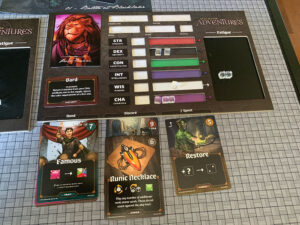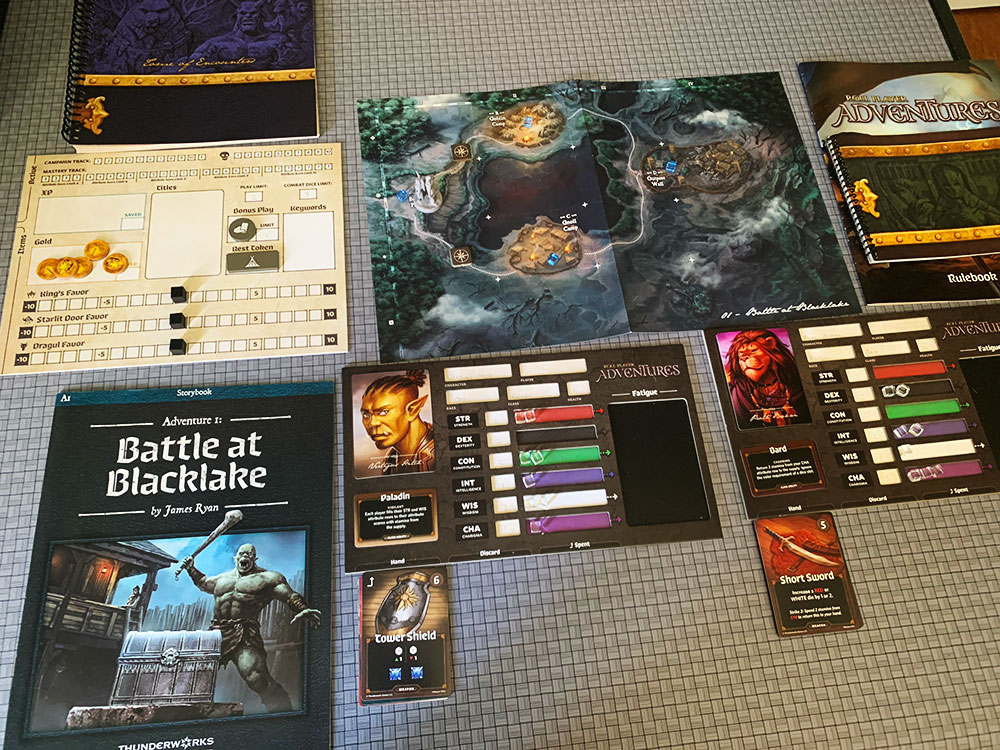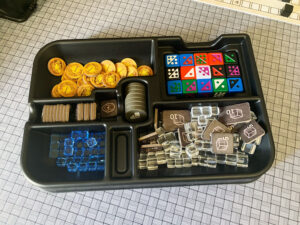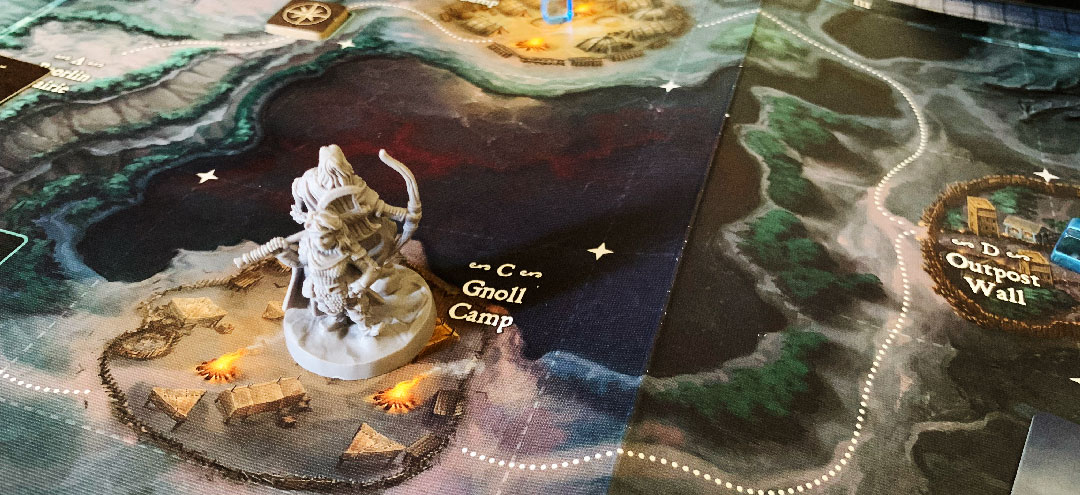 My first gaming love was Dungeons and Dragons. Like many people my age I started with the red and blue boxes before progressing to the Advanced D&D rules and played several other editions over the ensuing years. A lot of board games try to be that ever elusive RPG-in-a-box that doesn’t require a game master. Many of these games are tactical combat engines with character leveling with some narrative sprinkled throughout. There may be some choices but you’re on a linear path just hitting monsters until they drop some loot like an armored piñata with teeth.
My first gaming love was Dungeons and Dragons. Like many people my age I started with the red and blue boxes before progressing to the Advanced D&D rules and played several other editions over the ensuing years. A lot of board games try to be that ever elusive RPG-in-a-box that doesn’t require a game master. Many of these games are tactical combat engines with character leveling with some narrative sprinkled throughout. There may be some choices but you’re on a linear path just hitting monsters until they drop some loot like an armored piñata with teeth.
Roll Player Adventures looked more like an intricate choose your own adventure story with some dice-based puzzles that drove the story forward. Does Roll Player Adventures deliver as a role playing game in a box for people who don’t just want to fight their way across the entire board?
Gameplay Overview:
You can import your own characters from Roll Player or select a premade character to start your campaign. Each scenario has its own booklet that’s reminiscent of late first edition D&D modules and a map. The booklet provides a short summary and set up information and then you place tokens and XP cubes per the instructions and set your party miniature where instructed and you’re ready to roll.

Throughout the game, you’ll encounter different skill and combat encounters. For both, you can spend stamina cubes, at a cost of one per character in the party, to add a specific die color to your starting dice pool. You can blindly draw more dice until you’ve reached the dice pool limit. After rolling these dice you match up the color and values required. From just rolling dice chances are there are going to be open slots that need dice to succeed. And that’s where your hand of cards will never give you up and never let you down. Except if they do then monsters will turn around and hurt you.
Each player can play cards up to the allowable play limit. Players can get bonus play tokens that will allow for additional cards to be used up to the limit of bonus play tokens the party have. Cards allow players to add more dice to the dice pool, treat dice to be different numbers, and change values through rerolls, assigning, or flipping. Through your adventures, you will earn and buy new cards adding to your toolbox to handle more difficult challenges.

Combats can last for three rounds with enemies doing damage for each uncovered slot on their card and providing other negative effects for rounds two and three (usually damage, loss of treasure, or experience). If a character has stamina tokens in the spent box equal to or exceeding their health, they’re knocked out of the challenge. If all the characters are out, then the players lose the scenario and read the text in the tome of encounters for that mission.
Players collect XP for covering certain slots on skill checks, even if they failed the check. After each challenge, all cards in the discard piles can be returned to players’ hands. When players rest, they can regain their spent cards and recover stamina. Stamina recovery is based on rolling the number of dice equal to the XP you spent. But you want to be frugal with your XP spending as that’s also how you improve your characters.
At the end of each adventure XP and gold can be spent to improve your characters in what’s called advancement. XP is spent to increase abilities through the mastery track, increase health, add to the combat dice limit, and add extra bonus play tokens. Gold is used to buy items with some cards coming with discounts for character race or abilities.

Game Experience:
Some of the experiences I look for in an RPG-like game include character progression, a sense of adventure, character choices (this is the role-playing aspect), a narrative to get invested in, tactical combat, and an overall sense of discovery.
Apart from tactical combat, Roll Player Adventure delivers on all these facets. But that lack of tactical combat comes with very fast set up and tear down time at least in part due to the trays efficiently holding most of the components.

Characters progress through adding cards found or bought and through increasing abilities through advancing the mastery track. It’s simple and satisfying overall but, especially for solo players playing multi-handed, there are a lot of cards to keep track of. On the positive side as things get more complicated you end up having more dice and more cards to work with. And with a few exceptions, I found that after a few scenarios I could generally manipulate my way out of most problems fairly easily. It was very satisfying overall but, especially towards the very end, it did start to feel like a little tedious especially as the dice pools got larger and there were more dice to manipulate. But that may not be everyone’s experience.
One place where Roll Player Adventures excels is the branching story and the overall world-building as you travel to locations over the beautifully illustrated maps. Throughout each scenario, you will mark down keywords and collect scenario-specific items that you can interact with at different locations (sometimes to humorous results when used in combination). Keywords may direct you to different paragraphs and a different story experience than someone with a different keyword. You’ll also earn title cards that provide a small sentence or two of text which could impact the story in future scenarios. And by “could” I mean there’s an effect, but you won’t know if it’s good, bad, or sometimes both.

Despite all the branches, the main storyline is linear, and you’ll likely hit the same major plot points on repeated campaigns. Favoring different factions or making different choices will open up alternate vignettes of story and small experiences but probably without changing the cliff notes description of the overall story arc. In terms of overall replay value, I think it’s still pretty high if there’s sufficient time between campaigns. There are often times when you may have a choice in how to handle an encounter (offering different skill checks) so playing as different characters, with different hands of cards, will also offer different puzzles to solve.
Besides the main story, the dozens of characters that you’d meet and interact with add a lot of depth to the experience. I had played the first four or five scenarios fairly quickly when I first received my pledge and then put it aside to play some other games. I got back to it and decided I wanted to finish the campaign and played the remaining scenarios over a compressed timeline. When I started again, I couldn’t remember some of the names and their relationship with me (the title cards slowly reminded me). So, this is a game that probably plays best with regular play until you finish the 11-part campaign (plus a repeatable side quest that can be played after a certain point of the adventure). Rushing through the game started to feel tedious and waiting three months between sessions could have you lose the finer details of the world and the story arc.

Finally, I have two small complaints—one mechanical and one stylistically. Mechanically, my issue is that the combat and the skill checks are a little too similar. Combats last up to three rounds and sometimes have modifiers cards that do something (often bad for you) to adjust enemies but fighting an ogre, a gnoll, or a dragon doesn’t really feel that different mechanically from each other or than completing a different skill check. I still had a lot of fun with the game and was stressing out when I was calculating how hard I was going to get walloped at times because I couldn’t place enough dice but didn’t want to waste a card that turn because I didn’t have enough bonus play tokens to manipulate the new dice I would’ve drawn *breathes into paper bag*.
Stylistically, I had some issues initially differentiating some of the colors on the player boards, cards, and skill checks. The blues and purples were hard to tell apart for me. Because some cards had dark backgrounds and others had light backgrounds the appearance also changed which initially confused me a bit. I have a mild form of color blindness so this may not affect everyone.
Final Thoughts:
Roll Player Adventures edged out Solomon Kane for my pick as the best game of 2021 as I started the campaign. And even now it’s still a close call between those two, with Chronicles of Drunagor (which I first played in 2022), also in that discussion. Roll Player Adventures is a very solid entry for someone looking for an RPG in a box, especially if the story and world building are more important than tactical combat.
Final Score: 4.5 Stars – Roll Player Adventures gives players interesting choices as they progress through a fantastic choose-your-own-adventure story with engaging dice manipulation puzzles in a deep and vibrant world.
 Hits:
Hits:
• Fantastic world building and narrative
• Fun dice manipulation puzzles
• Choices have downstream ramifications
Misses:
• Combat and skill checks are similar
• Time gaps between plays can make it hard to remember characters you’ve previously met
• Some stylistic choices are not the most colorblind friendly
Source: Board Game Quest






